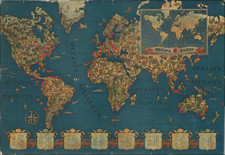Fine, Early World Map from Porcacchi’s Popular Books of Islands
Nice example of Porcacchi's early chart of the world, from his bestselling isolario, L'Isole Piu Famose Del Mondo.
The map is modeled on a sea chart and is criss-crossed with rhumb lines, suggesting navigation to the islands that were the book’s subject matter. It shows the habitable world as it was then known to Europeans, omitting the open Pacific Ocean. This truncation suggests that Asia and America are connected to each other.
South America is shortened and thickened, a depiction that borrows from the early work of Mercator, among others. Florida is also blunted, its thin, peninsular shape still largely unknown to European mapmakers. Cities in the Americas include Cusco, Temistitan (a reference to Tenochtitlan, the capital of the Aztec Empire, today Mexico City), and the mysterious Ipedra.
Also included is Ciola ora Granada, a reference to the El Dorado myth of a city of gold in the North American interior. There were reportedly seven cities of gold, including Cibola and Gran Quivira. In 1540, this belief, likely combined with various indigenous legends, led Francisco Vázquez de Coronado to embark on an (unsuccessful) expedition to find these mythical cities.
Terra Incognita
In the Indian Ocean, Madagascar is called S. Lorenzo, a name given it be Portuguese traders. The most impressive island on the map, however, is the massive, continent-sized Terra Incognita that unfolds across the southern expanses.
Sixteenth-century geographers theorized that a huge southern continent was necessary to balance the weight of the continents in the northern hemisphere. Certain European encounters seemed to support the theory. For example, Tierra del Fuego is included as part of Terra Incognita here. This is because, when named by Magellan during his transit in the Strait of Magellan from Atlantic to Pacific, he did not know that the land to the south was an island. Only in the early seventeenth century would Dutch traders round Cape Horn, proving Tierra del Fuego’s insularity.
At the easternmost part of Terra Incognita is another place name, Terra de Luchac. Lucach would be familiar to anyone who has read Marco Polo’s Travels. It was a region in Java. This conflation of Java with the southern continent stemmed from an error. Initially, Polo used Arabic usage of Java Major for Java and Java Minor for Sumatra. After a printing mistake made Java Minor seem the largest island in the world in the 1532 edition of Polo’s Travels (Paris and Basel), mapmakers started to include the Java regions in the southern continent, then thought to be the largest island in the world.
Taprobana
Far to the east, Taprobana collides with the eastern border of the map. Taprobana was what the Greeks called Sri Lanka, but late-medieval and early modern geographers also applied the toponym to Sumatra and various phantom islands that wandered the Indian Ocean. Some of the confusion stemmed from the caginess of merchants with the location of many islands. Sri Lanka and Sumatra, for example, were both rich in resources, especially spices, and those who had access to these resources were loath to share the bounty.
There were also many rumors about the island in Europe. The author of The Travels of Sir John Mandeville said that Taprobana was part of the kingdom of Prester John, as well as that the island had mountains of gold guarded by man-eating ants. He went on to explain that the island was the home of the Sciapodes, or men with only one large foot, a detail he borrowed from Greek sources.
Porcacchi’s world maps in L'Isole Piu Famose Del Mondo
Porcacchi included two world maps in his isolario, or book of islands. Books of islands were very popular in the early modern period, especially in Italy. Several early manuscript volumes are known. The earliest printed isolario was published in ca. 1485 by Sonetti and included 49 maps of the Greek islands.
The second isolario was by Benedetto Bordone, published in Venice in 1528. It greatly expanded the subject matter as it attempted to chart the islands of the entire world. It also included a world map, setting a trend for later isolarios.
Porcacchi’s contribution to the genre was first printed in Venice in 1572. His work included two world maps. The first map, on an oval projection, is based on Camocio’s much larger world map of 1567, which itself was derived from Gastaldi’s famous world map of 1546.
The second world map in the book was this Carta da Navigare, or navigation chart. Both maps were engraved by skilled book illustrator Girolamo Porro, of Padua.
Porcacchi’s pocket-sized isolario proved popular. It was reprinted in 1576, 1590, 1604, 1605, 1620, 1686, and 1713. By 1620, the plates were becoming worn, making earlier, more firmly printed examples like this more desirable.









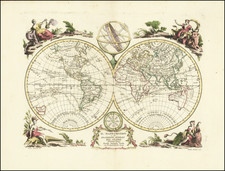
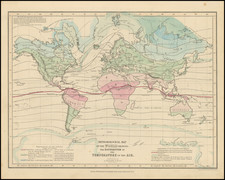
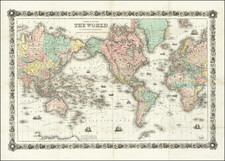
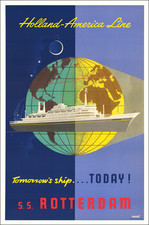
![[Early Photographic Facsimile of the Rosselli-Sonetti Woodblock World Map] Figura & Scrittura in soma di tutti lo habitato](https://storage.googleapis.com/raremaps/img/small/66515.jpg)
